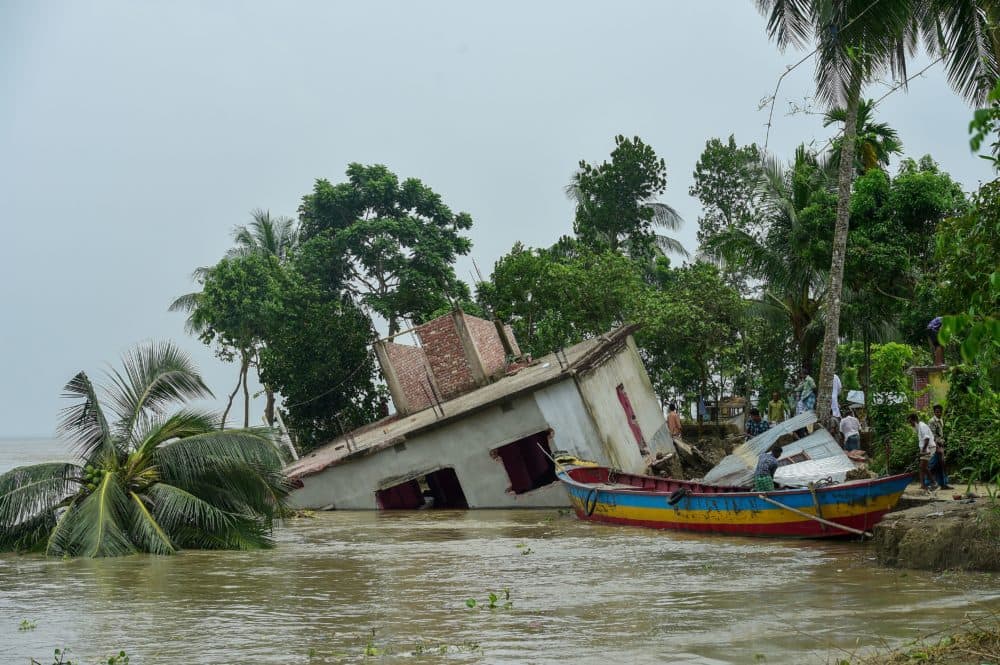Advertisement
The case for climate reparations
Resume
Listen to a First Person diary on how climate change shapes the community of Kivalina, Alaska here.
There’s a tragic irony to climate change, according to New York Magazine editor David Wallace-Wells:
“The rich countries of the world ... that have produced this warming, they’re not in such hot parts of the world," he says. "The Global South in particular are being hit much more intensely, and they bare very little responsibility for the crisis.”
Wallace-Wells says the U.S. would not be where it is today if not for a century spent burning fossil fuels.
"You could really closely correlate their economic and even geopolitical standing with how much they’ve done to the planet," he adds.
So how can America grapple with the implications of climate change? Wallace-Wells says only through an honest and moral reckoning:
"[It] requires those of us in these rich and powerful countries to leverage that wealth and that power towards helping those who are suffering the most from our pollution," he says.
Today, On Point: David Wallace-Wells makes the case for climate reparations.
Guests
Riton Quiah, field coordinator and producer based in Bangladesh who’s worked with the BBC, Wall Street Journal, National Geographic and many more news outlets. (@fixerBD)
David Wallace-Wells, deputy editor of New York Magazine. Author of "The Uninhabitable Earth." (@dwallacewells)
Also Featured
Olúfẹ́mi O. Táíwò, assistant professor of philosophy at Georgetown University.
Colleen Swan, interim city administrator in Kivalina, Alaska.
Show Highlights: How climate change impacts Bangladesh
Bangladesh is a nation of rivers. The mouths of South Asia's holiest rivers, the Ganges, the Padma, the Yamuna and more exit through Bangladesh and into the Bay of Bengal. That same water makes Bangladesh one of the most climate vulnerable countries in the world. Floods, cyclones, storm surges.
Over the past decade, hundreds of thousands of Bangladeshis have been displaced by climate disasters.
It's estimated that by 2050, one in seven people in Bangladesh will have to move because of sea level rise alone. That's potentially 18 million people, more than twice the entire population of New York City.
Riton Quiah, a field coordinator and producer based in Bangladesh, walks us through the climate crisis in Bangladesh.
What was the annual weather cycle like in Bangladesh when you were a child?
"I heard in 1970, that was maybe the biggest, or largest or strongest cyclone. ... Nowadays it's called Cyclone Bhola. So maybe half a million people died in 1970 and it was very close to my house. My home district is in Noakhali. ... And Bhola was very, very close, just west. And my mother, she said in that, thousand and thousand people died. Even she saw those types of things.
"In 1998, at the time we saw floods. In 1991, we saw again cyclone. There was no name for cyclone at the time in Bangladesh. But very recently like 2006 ... then 2009. ... So in that way, it is gradually increasing. And nowadays, when I work in the field, mainly in the southern side of Bangladesh, for international media or for research work for the University of Texas, I have been seeing people they would like to say in their lifetime when they were very young, like me, they didn't see lots of cyclones. But nowadays, there is more than two or three or four cyclones coming, and those are very strong."
One in seven Bangladeshis could be permanently displaced by climate change in the next few years. What's the potential impact of that on Bangladesh?
"Bangladesh, it's a very small country, like [the size of] New York City. … Years ago, the students, when they complete education, they tried to go in Dhaka for a job, but now it is the total family [that] needs to move in Dhaka because nothing … is remaining in the country. I do not have any specific data, but from some reports I have seen, like 1,000 to 2,500 people hitting the city areas almost every day. And I know some areas … in 2009, after Cyclone Aila, there was a survey completed by a local NGO that showed within two years, 688 family moved. And if you count five family members in each family, then it will be a 3,500 or 4,000 people … after one cyclone.
"And I know another place that is in Ramjannagar in Satkhira district. So, there were 314 families. Now only 80 families living. … You don't know many things: how many people are joining, or coming in the main city into disaster because their life is very vulnerable. They don't know the train track, they don't know the main road, they don't know the exact location they need to go in Dhaka city. So, it is an unbelievable situation because the government cannot control everything. And you know, this is bad. Bangladesh – it is not going in a systematic way. It's not like the USA. It’s Bangladesh."
From The Reading List
New York Magazine: "Climate Reparations" — "The math is as simple as the moral claim. We know how much carbon has been emitted and by which countries, which means we know who is most responsible and who will suffer most and that they are not the same."
This program aired on November 8, 2021.

